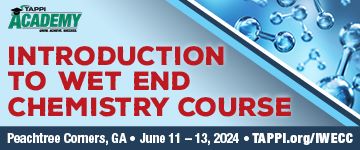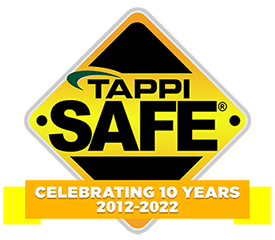 Search
Search
Use the search bar or filters below to find any TAPPI product or publication.
Filters
Content Type
Publications
Level of Knowledge
Collections
Journal articles

Magazine articles

Lignin-based resins for kraft paper applications, TAPPI Journal November 2019
ABSTRACT: We investigated miscanthus (MS) and willow (W) lignin-furfural based resins as potential reinforce-ment agents on softwood and hardwood kraft paper. These resins might be sustainable alternatives to the commercial phenolformaldehyde (PF) resins. Phenol is a petrochemical product and formaldehyde has been classified as a carcinogen by the U.S. Environmental Protection Agency. The lignin used in this study was derived from hot water extraction (160ºC, 2 h) of MS and W biomass, and may be considered sulfur-free. These biorefinery lignins were characterized for their chemical composition and inherent properties via wet chemistry and instrumental techniques. The resin blends (MS-resin and W-resin) were characterized for their molecular weight, thermal behavior, and mechanical properties. Mechanical properties were measured by the resin’s ability to reinforce softwood and hard-wood kraft papers. The effect of adding hexamethylenetetramine (HMTA), a curing agent, to the resin was also examined. Mixtures of PF and lignin-based resins were investigated to further explore ways to reduce use of non-renewables, phenol, and carcinogenic formaldehyde. The results show that lignin-based resins have the potential to replace PF resins in kraft paper applications. For softwood paper, the highest strength was achieved using W-resin, without HMTA (2.5 times greater than PF with HMTA). For hardwood paper, MS-resin with HMTA gave the highest strength (2.3 times higher than PF with HMTA). The lignin-based resins, without HMTA, also yielded mechanical properties comparable to PF with HMTA.
Magazine articles

Contributing causes and risk reduction of crevice corrosion, TAPPI JOURNAL, November 1998, Vol. 81(11)
Contributing causes and risk reduction of crevice corrosion, TAPPI JOURNAL, November 1998, Vol. 81(11)
Magazine articles

Extend the life of your hoists, TAPPI JOURNAL, February 1994, Vol. 77(2)
Extend the life of your hoists, TAPPI JOURNAL, February 1994, Vol. 77(2)
Magazine articles

Pump bearings: a new bearing system to improve reliability, TAPPI JOURNAL, March 1990, Vol. 73(3)
Pump bearings: a new bearing system to improve reliability, TAPPI JOURNAL, March 1990, Vol. 73(3)
Magazine articles

Measuring customer perception of print quality, TAPPI JOURNAL, March 1990, Vol. 73(3)
Measuring customer perception of print quality, TAPPI JOURNAL, March 1990, Vol. 73(3)
Magazine articles

The r & t system: everyone is responsible for innovation, TAPPI JOURNAL, September 2000, Vol. 83(9)
The r & t system: everyone is responsible for innovation, TAPPI JOURNAL, September 2000, Vol. 83(9)
Journal articles

Magazine articles

Flocculation of fiber suspensions studied by Rheo-OCT, TAPPI Journal September 2024
ABSTRACT: When dealing with papermaking fiber suspensions, particle flocculation takes place even before the paper web is formed. The particle flocculation depends on several aspects, including particle mass concentration (consistency), particle collisions, electrochemical interactions promoted by chemical additives, etc. Due to its importance, fiber suspension flocculation has been studied for a long time in papermaking, and several methods have been developed for this purpose. The traditional techniques include, for example, focused beam reflectance microscopy (FBRM) and high-speed video imaging (HSVI). Recently, a new optical method, optical coherence tomography (OCT), has emerged for flocculation analysis. The advantages of OCT are the possibility to study opaque suspensions, its micron-llevel resolution, and its high data acquisition speed. The OCT measurements can be combined with rheological (Rheo) measurements, allowing simultaneous measurement of both the time evolution of the floc size and the suspension viscosity. In this work, we used this approach, Rheo-OCT, to study the flocculation of suspensions of various papermaking furnishes. We analyzed the time evolution of the floc size and the fiber suspension viscosity when the studied papermaking suspensions were treated with highly refined furnish (HRF) — a furnish that contained a significant amount of micofibrillated cellulose (MFC)-type fibrils — and/or chemical additives. Such studies can lead to a better understanding of the impact of flocculation on the produced paper web in terms of qualities like formation, drainage potential, and strength behavior.
Journal articles

Magazine articles

Effects of tissue additives on copy paper forming and properties, TAPPI Journal February 2024
ABSTRACT: Laboratory tests were conducted in an effort to determine the effects on paper machine process attributes and the properties of paper made from recycled copy paper furnish upon the addition of chemical agents that are commonly used in the production of hygiene tissue products. Due to continuing growth in tissue and towel grades of paper, such agents are experiencing greater usage. Charge titration test results revealed that certain dry strength agents associated with tissue manufacturing have the potential to shift the balance of charge in papermaking furnish to less negative or even positive values. Creping adhesive was found to contribute to fine particle retention, especially when present at relatively high levels. Release aid and a polyacrylate dispersant had the opposite effect. Low addition levels of both a creping adhesive and a debonding agent surprisingly increased a wide range of strength attributes of paper handsheets in comparison to sheets prepared from unaltered recycled copy paper furnish. The debonding agent decreased paper strength at higher levels of addition. Such effects appear to depend not only on the expected effects of agents themselves, but also on how they affect the charge balance of the wet-end system.
Journal articles

Magazine articles

Quantification of hardwood black liquor contamination in pine black liquor, TAPPI Journal February 2024
ABSTRACT: The presence of hardwood black liquor contamination in pine black liquor can negatively impact brownstock washer and evaporator operation, as well as reduce soap separation and yield. It is also believed to negatively impact commercial kraft lignin production. It was desired to develop a method of quantitatively determining the amount of low-level hardwood liquor contamination in pine black liquor. A method employing pyrolysis-gas chromatography mass spectrometry (py-GCMS) was developed to perform the desired measurement. Laboratory cooks with carefully controlled blends of pine and hardwood chips were prepared, and the resulting liquor was measured using this technique. Additionally, samples of pine and hardwood black liquors were blended in known quantities and analyzed. All these samples were submitted as blind samples. The resulting analysis suggests the py-GCMS method was able to accurately determine the level of hardwood contamination between 1% to 10% hardwood liquor using a low-level calibration curve prepared with coniferyl alcohol and sinapyl alcohol as standards.
Journal articles

Magazine articles

Water chemistry challenges in pulping and papermaking • fundamentals and practical insights: Part 2: Conductivity, charge, and hardness, TAPPI Journal June 2023
ABSTRACT: Although water is essential to the papermaking process, papermakers often overlook its importance and focus on fibers, fillers, and chemical additives. A better understanding of water properties and chemical interactions associated with water at the wet end leads to a sound foundation for high-quality paper production and smooth operation. Water is an excellent solvent for ionic substances, both organic and inorganic. These substances contribute to system conductivity, charge, and hardness and significantly impact the papermaking process. Part 1 of this paper, published in TAPPI J. 21(6): 313(2022), discussed fundamental water properties, water chemistry, and the impact of pH on pulping and papermaking operations. In this paper, we review definitions, sources, and the typical symptoms of the effect of conductivity, charge, and hardness on the productivity of the papermaking process. Sources of conductivity, charge, and hardness impacting these factors, measurement methods, and available correction strategies for their control are also discussed.






